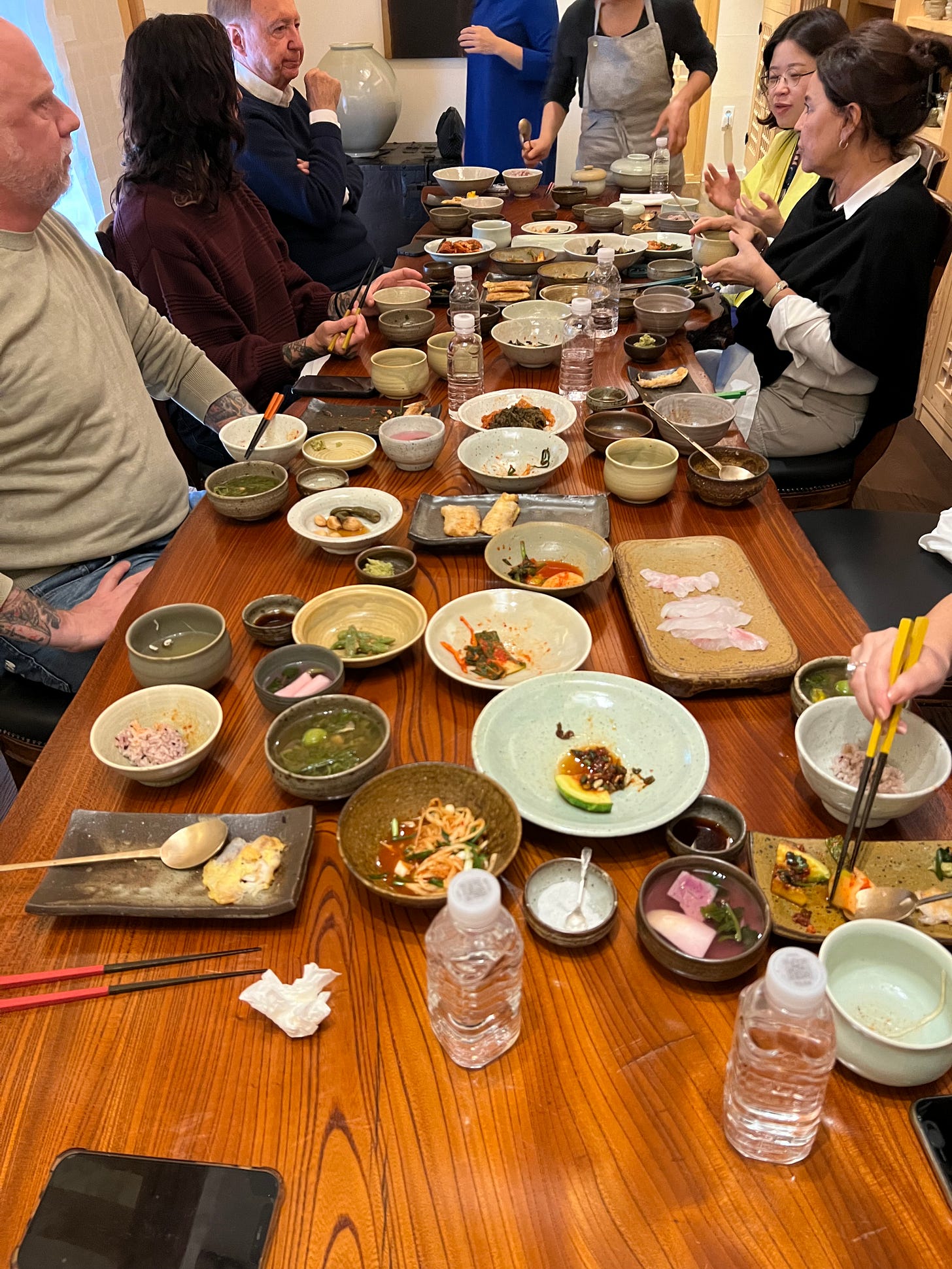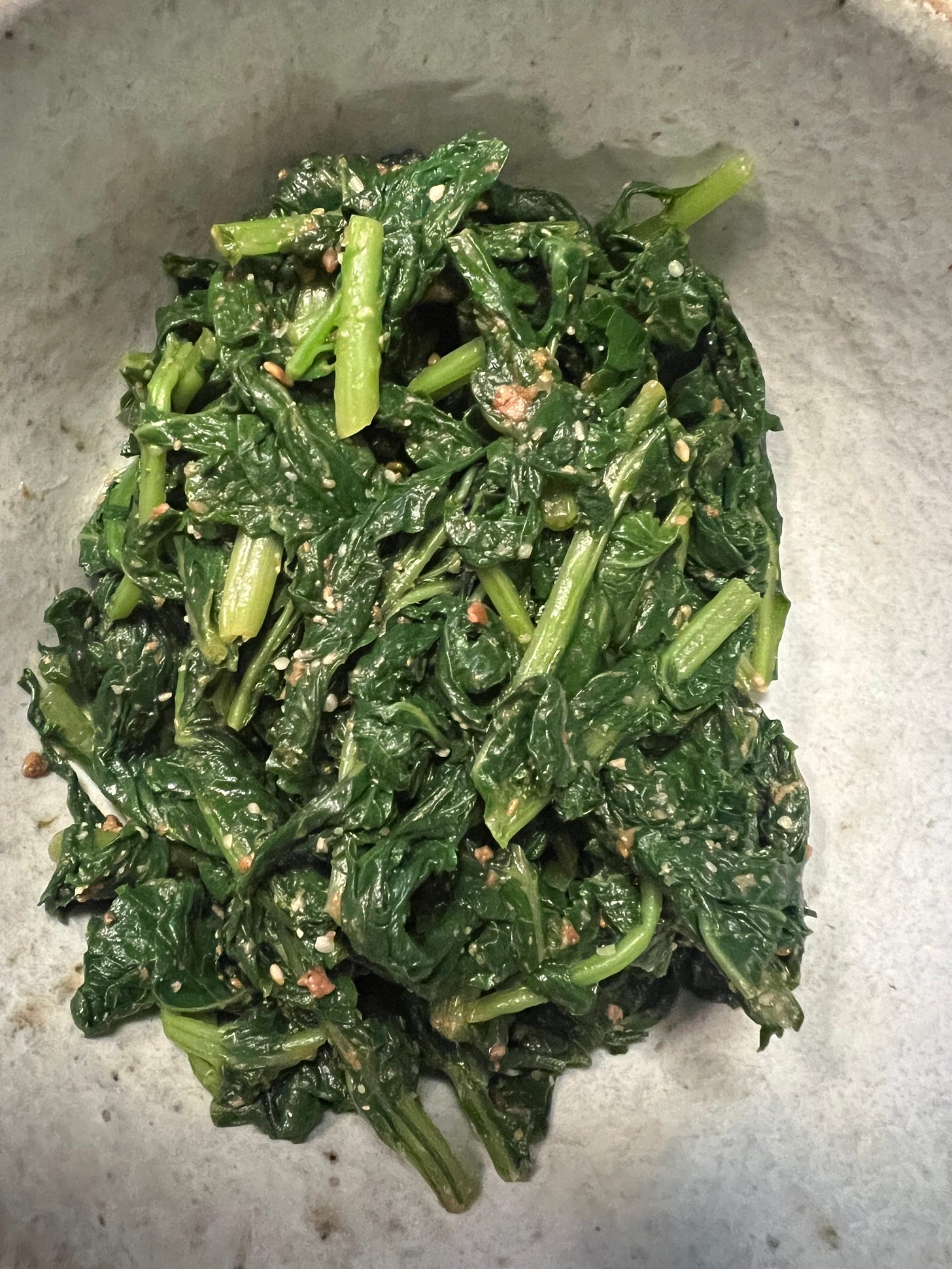Issue #127: Vegetable Side Dish Heaven
On Restaurant Boycotts, My Korean Cooking Exploration Continues, Two Recipes for Vegetable Dressings
Although hard to believe, we are actually at the point where people—not just people, but food people!—are calling for a boycott of Israeli restaurants in America (owned by Americans) to apply pressure against Israel for its treatment of Palestinians (see article). Let’s leave aside for a moment the horrific, bloody massacre of 1,400 Israeli civilians on October 7, which might make one consider avoiding Palestinian restaurants for a while. But to boycott an independently owned restaurant in America to apply pressure on a far-away state seems beyond ridiculous to me. It’s scary.
If the human rights scorecard of the country invoked by a restaurant or food business operated by immigrants (or anyone) in America is a criterion for the decision about where to have dinner, I guess we should boycott Chinese restaurants, Russian restaurants, Turkish restaurants, Afghani restaurants, and Iranian restaurants, too, right? I know I’m supposed to believe that this call for a boycott is not antisemitic, that it’s just a peaceful protest against right-wing Zionists, whom I agree have led Israel into unsupportable policies toward Palestinians in both Gaza and the West Bank. But why then are Israeli restaurants here in America the only ones being held to account for what their titular country does? What possible unique characteristic do Israeli restaurateurs and chefs have in common that others don’t? As with all matters of bias and injustice, whether the intention is to discriminate or not, the effect is what matters. Such a blanket boycott ends up unfairly targeting Jewish American restaurateurs and chefs. This is a dangerous, slippery slope. —Mitchell
As I wrote in Issue #125, I’m just back from a mind- and palate-blowing trip to Korea, during which I was exposed to a wide swath of traditional and contemporary Korean food. It was all fabulous. There is much more to explore. I came back excited to get in the kitchen.

I’ve had several Korean cookbooks on my shelf for years, but it was the combination of this trip, some grocery shopping I did while there, and the arrival of Phaidon’s Korean Cookbook by my friends Junghyun Park and Jungyoon Choi that really got me cooking. It’s exciting to explore a new (to me) cuisine, especially one as time-honored and distinct as Korean.
Don’t worry, this is not going to turn into a Korean food newsletter. I’m too much of an omnivore to keep to one cuisine. But I will be exploring various categories of Korean cooking in the coming weeks and months. Just last night I made miniature mung bean pancakes seasoned with ground meat, Korean scallions, and fermented greens (nokdu buchimgae) as an hors d’oeuvre for an otherwise Mediterranean meal.
At the Table
In addition to the food itself, the style of eating in Korea intrigues me. The new Netflix miniseries A Nation of Banchan, spotlights the Korean love of side dishes or banchan, those myriad little bowls and plates of tasty things that are often already set on the table when you sit down in a Korean restaurant. Banchan can be kimichi and other fermented foods, salads, dressed vegetables, meats, seafood, pancakes, fritters, just about anything. More than hors d’oeuvres or condiments, these little dishes make the meal. Banchan are so fundamental to Korean food that at one time there were royal decrees about how many could be served—only the king’s table was set with twelve, everyone else was limited to a maximum of nine.
In a Korean home or restaurant, the table is often set with dozens of banchan before you sit down. Sometimes the side dishes are arranged in the kitchen and then the table is carried into the dining room. Either way, more dishes are certain to arrive while you eat. This is an exciting way to experience a meal.

Within this model there’s an interesting power dynamic that unfolds, one that I think we could use a little more of in western dining. Once the table is set with an array of banchan, the chef is basically done. It’s up to the diner to determine how to eat. Ssam is one common option that involves wrapping bits of the food in leaves, often lettuce, but just about anything, from dandelion greens to shiso. We were offered fermented ramps and fermented wasabi leaves for ssam. Bascially, you take a little of this, some that, some fermented paste, a piece of kimichi, some fresh chilies, wrap it up, and pop it in your mouth.
Throughout the meal, everyone creates his or her own taste combinations from the banchan that keep arriving. The diner is in control. When you ask how you’re supposed to eat something, you rarely get a definitive answer. Instead, you’ll hear, “Well, I like it like this.” It’s an interesting inversion of the chef’s role in determining how we are supposed to eat the food, a liberating alternative to the constriction imposed by the endless parade of ego-driven courses you receive in many fine-dining restaurants these days. Forget, “The chef suggests you use a fork and eat the dish in a clockwise order.” Instead, “Have at it!”
In the Kitchen
With the help of the Korean Cookbook, I’ve been playing around with the simplest of banchan, leafy greens and other vegetables tossed in a flavorful dressing known as namul. Namul refers both to the botanical category of leafy greens and to the dishes made from them. If the vegetables are raw, they are called saengchae namul. If they are cooked, they are sukchae namul. I have been making a lot of both.
I’ve been experimenting with two basic types of sukchae namul dressing I want to share with you, one nutty from sesame, the other spicy from chili. (Park and Choi’s book includes sweet and sour versions of both, too, for which you add some sugar and rice wine vinegar.) You simply cook the vegetable, prepare the dressing, and toss together to serve. The variations and combinations are limitless. And the experimentation is fun.
Although here in the U.S. we often think of Korean barbecue and meat when we think of Korean food, as much as 70% of the traditional Korean diet is comprised of vegetables. These simple namul preparations are fundamental.
RECIPE: Sesame Vegetable Dressing
2 tablespoons light soy sauce or doenjang (fermented soybean paste)
1 tablespoon toasted sesame oil
1 tablespoon toasted sesame seeds, whole or ground
In a small bowl, mix all of the ingredients to form a smooth paste.
RECIPE: Spicy Vegetable Dressing
2 tablespoons gochujang (fermented chili paste)
1 tablespoon toasted sesame oil
1 tablespoon toasted sesame seeds, whole or ground
In a small bowl, mix all of the ingredients to form a smooth paste.
To use these dressings, simply prepare any leafy green vegetable, such as spinach, mustard greens, bok choy, broccoli raab, radish tops, or what have you. About 8 to 12 ounces should be right for this amount of dressing. Clean and blanch your vegetable in salted water. Chill in an ice bath, drain, and squeeze out any excess moisture. Cut the vegetable into bite-size pieces, if you like, and toss in one of the dressings. Note that because of the deep umami flavor of these dressings, a little goes a long way. They are not sauces as much as enhancements. You don’t want to over do it. The flavor of the vegetable should come through.





This is really interesting, Mitchell. I'm not up to trying any of these ideas but I'm truly fascinated to learn about them--not just a whole new cuisine but a whole new way of eating. One thing I do wonder: is this meze tradition (as I immediately thought of it) typical of ordinary home cooking? Or is it special occasion and restaurant food?